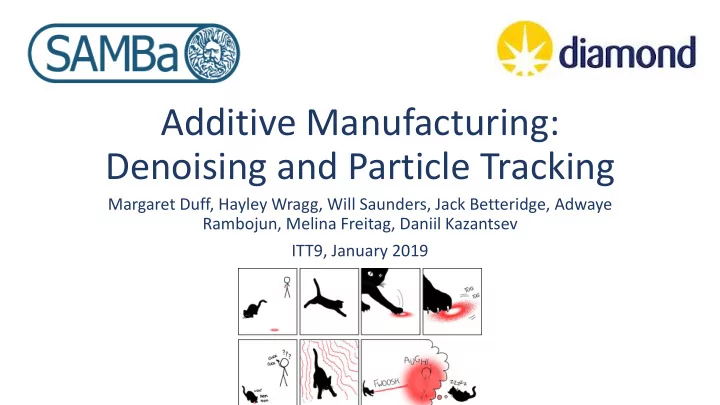

Additive Manufacturing: Denoising and Particle Tracking Margaret Duff, Hayley Wragg, Will Saunders, Jack Betteridge, Adwaye Rambojun, Melina Freitag, Daniil Kazantsev ITT9, January 2019
The Distilled Problem • Find the velocity of the particles displaced from the surface • Investigate the geometry of the molten material • Tracking the laser across this image • Obtain 3D information from the 2D images Additive Manufacturing: Denoising and Particle Tracking | ITT9 | January 2019
Current Work: Laser Tracking 370 1 𝑢 − 𝑣 𝑗,𝑘 𝑢+𝜀𝑢 = 𝑅 𝑢,𝑘 30 𝑣 𝑗,𝑘 𝑗=340 340 370 • Small strip across the boundary of new and 𝑅 old material considered • Residuals taken between frames • Vertical averages on residuals created a 1D Time vector for each frame • New image of these concatenated vectors x-axis Additive Manufacturing: Denoising and Particle Tracking | ITT9 | January 2019
Laser Tracking: Line Detection Line Detection: • Gradient – Sobel x-direction −1 0 +1 𝐻 = ∗ 𝑅 −2 0 +2 −1 0 +1 • Otsu thresholding • Hough line detection 𝑦 cos(𝜄) + 𝑧 sin(𝜄) − 𝜍 = 0 • Points (𝑦, 𝑧) correspond to sinusoidal curves parameterised by (𝜍, 𝜄 ). • Intersection points in the parameter space correspond to points lying on the same straight line in the image space. • Still more work to be done Additive Manufacturing: Denoising and Particle Tracking | ITT9 | January 2019
Current Work: Mumford-Shah smoothing and image segmentation • AIM - segmentation of the molten area in order to investigate its geometry • IDEA – Mumford-Shah implementation for denoising and segmentation Find a noisy image 𝑣 0 wish to find a smoothed image 𝑣 and a segmentation • 𝐿 which minimises the functional: 𝑣 − 𝑣 0 2 𝑒𝑦 + 𝜇 ∇𝑣 2 𝑒𝑦 + 𝛽 ⋅ length(𝐿) • Fidelity term – ensures smoothed solution close to the noisy image • TV denoising term – smooths while maintaining discontinuities • Geometric term – minimises length of the edges of the segmentation Additive Manufacturing: Denoising and Particle Tracking | ITT9 | January 2019
Mumford-Shah: Results Additive Manufacturing: Denoising and Particle Tracking | ITT9 | January 2019
Current Work: Velocity Field Distribution • Try to approximate the underlying velocity vector field from the video frames. • Consider each video frame as a density field. 𝑢+𝜀𝑢 − 𝜍 𝑗,𝑘 𝑢 = 𝑣 𝑗−1,𝑘 − 𝑣 𝑗,𝑘 + 𝑤 𝑗,𝑘−1 − 𝑤 𝑗,𝑘 𝜍 𝑗,𝑘 • Least squares solver ( 2𝑜 unknowns for 𝑜 equations ) Advantages Challenges Avoids tracking individual particles The source data is noisy Should allow characterisation of the velocity field Signal to noise ratio is poor Additive Manufacturing: Denoising and Particle Tracking | ITT9 | January 2019
Velocity Field Distribution: Approach • Let 𝑤 = 𝑤 𝜍 + 𝑤 𝜗 𝜐 𝑤 𝜗 𝑒𝜐 = 0 = 𝑤 𝜗 𝑒𝑦 0 𝑔𝑠𝑏𝑛𝑓 • Idea: a "short" time average should remove errors in the velocity field • Can also apply other noise reduction techniques prior to applying our approach. Additive Manufacturing: Denoising and Particle Tracking | ITT9 | January 2019
Velocity Field Distribution: Results Original Additive Manufacturing: Denoising and Particle Tracking | ITT9 | January 2019
First Attempt Additive Manufacturing: Denoising and Particle Tracking | ITT9 | January 2019
With denoising Additive Manufacturing: Denoising and Particle Tracking | ITT9 | January 2019
Overlay Additive Manufacturing: Denoising and Particle Tracking | ITT9 | January 2019
Future Work • Kalman filters for image denoising • Digital Image Correlation for particle tracking • Develop a physical model • Detection of 3D motion from 2D images • Echo state networks for analysing dynamics of the system Questions! Additive Manufacturing: Denoising and Particle Tracking | ITT9 | January 2019
Recommend
More recommend